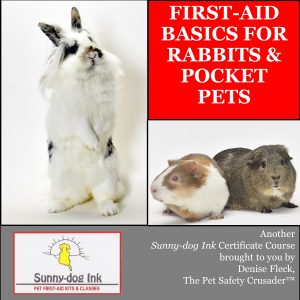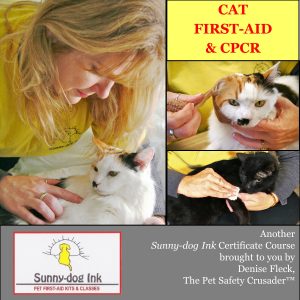 During this action-packed time of year, people, decorations, tempting foods and human medicines (which get some humans through the season) are in abundance, so be double-dog sure you keep dangers out of paws reach, but know how to react and where to go should the worst happen. Veterinarians are the experts, but most of us are not lucky enough to have one velcroed to our hip 24/7. Even if you live in a house with 10 humans, the cat is going to choke and the dog will cut his paw when you are home alone and AFTER veterinary hours, so you know what to do (pet first aid – more about that tomorrow) BEFORE professional medical care is available!
During this action-packed time of year, people, decorations, tempting foods and human medicines (which get some humans through the season) are in abundance, so be double-dog sure you keep dangers out of paws reach, but know how to react and where to go should the worst happen. Veterinarians are the experts, but most of us are not lucky enough to have one velcroed to our hip 24/7. Even if you live in a house with 10 humans, the cat is going to choke and the dog will cut his paw when you are home alone and AFTER veterinary hours, so you know what to do (pet first aid – more about that tomorrow) BEFORE professional medical care is available!
Don’t wish you HAD learned Pet First Aid was one of the first quotes I received from a student after taking my Pet First Aid Class and it works! As with anything in life, don’t wait until tragedy strikes before you learn animal life-saving skills, and brush up on them regularly, cause…”if you don’t use it, you lose it!”
Knowing what to do BEFORE you get to veterinary care (lowing body temperature, controlling bleeding, alleviating choking, inducing vomiting in the case of poisoning or actually administering rescue breathing and CPR) can really make a difference in recovery and survival of your dog or cat.
When you commit to bringing a four-legged family member into your heart and your home, it is your responsibility to make sure you can provide everything that dog or cat needs for his or her lifetime.
 Rule Number One…stay calm! Pets are very perceptive to our vibes and will act accordingly. Restrain your pet by shooing her into a bathroom so that she can’t hide under the bed, and control her kitty claws by swaddling her in a towel. Have a properly fitting muzzle available cause if you are bitten, it becomes a human first aid incident and your pet won’t get the prompt care. Well over 50% of cat bites result in humans needing professional medical care as opposed to only 5% of dog bites.
Rule Number One…stay calm! Pets are very perceptive to our vibes and will act accordingly. Restrain your pet by shooing her into a bathroom so that she can’t hide under the bed, and control her kitty claws by swaddling her in a towel. Have a properly fitting muzzle available cause if you are bitten, it becomes a human first aid incident and your pet won’t get the prompt care. Well over 50% of cat bites result in humans needing professional medical care as opposed to only 5% of dog bites.
If your pet swallows a food item that he should not have (any non-caustic poison that doesn’t burn the esophagus), after contacting your Veterinarian, Pet Poison Control (888) 426-4435 or Pet Poison Helpline (855) 764- 7661, induce vomiting by administering 1 Tablespoon 3% Hydrogen Peroxide for every 10-15 lbs. you pet weighs through an eye dropper or needless syringe onto the back of her tongue. If this doesn’t cause emesis (vomiting) within 30 seconds to 5 minutes, seek immediate veterinary care. However, if you are a cat parent…this is totally the wrong move! Get to your veterinarian at once. Do not try to induce vomiting in a cat.
 For bleeding, apply direct pressure with a clean gauze pad until bleeding stops. You can elevate the limb on a folded towel to assist and if bleeding is on a leg, press on the appropriate pressure point (major artery inside the specific limb — femoral or brachial).
For bleeding, apply direct pressure with a clean gauze pad until bleeding stops. You can elevate the limb on a folded towel to assist and if bleeding is on a leg, press on the appropriate pressure point (major artery inside the specific limb — femoral or brachial).
For upset tummies, 1 teaspoon of Mylanta for a 10-15 lbs pet (not Pepto as it contains too much salicylic acid for pets) and letting the stomach rest by withholding food but making sure he drinks water, should alleviate simple digestive upsets, but if blood is present in vomit or diarrhea or if these are symptoms of an illness or obstruction, seek immediate veterinary care.
Feeding 1/2 teaspoon daily of pure pumpkin puree (buy canned or rehydrate dry) often aids with fur balls, and 1-3 Tablespoons (depending on canine size) can help with diarrhea, constipation and even expressing those anal glands, but…the best holiday gift you can give yourself and your pet is the gift of learning or brushing up on your pet first aid skills!

 Sign-up for a class today, no matter where you live. Besides in-person, I teach LIVE via teleconference and also have recorded webinars where you can take a self-guided journey into learning how to be an even better and well-prepared dog, cat, rabbit, bird or pocket pet parent!
Sign-up for a class today, no matter where you live. Besides in-person, I teach LIVE via teleconference and also have recorded webinars where you can take a self-guided journey into learning how to be an even better and well-prepared dog, cat, rabbit, bird or pocket pet parent!
 Don’t wish you HAD learned pet first aid!
Don’t wish you HAD learned pet first aid!








